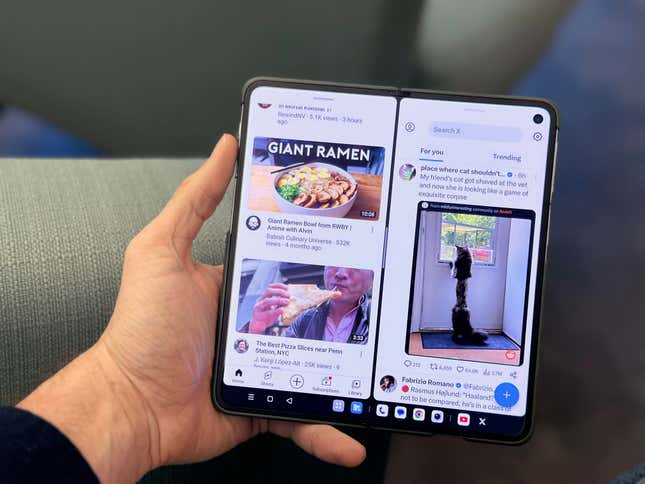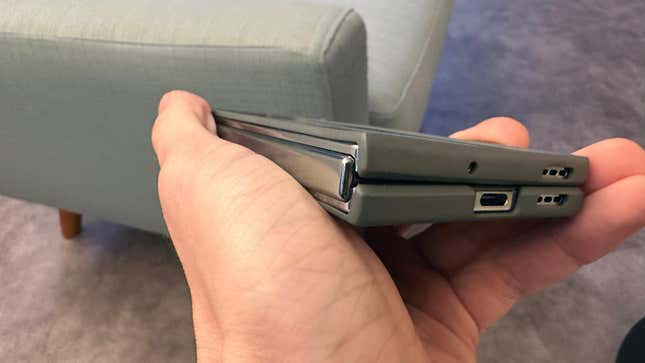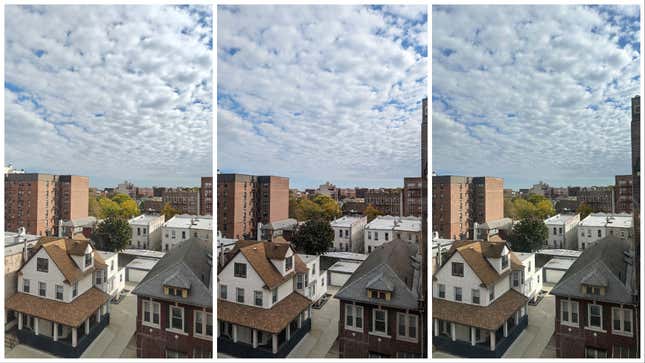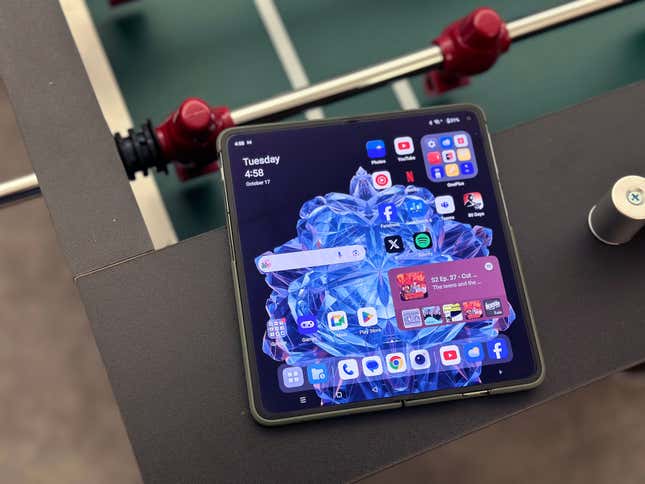Compared to a few of my coworkers, I’ve been a real Debbie Downer regarding foldables. Huddled for drinks or games with friends, I’d receive the usual “oohs” and “ahhs” every time I took out a new foldable I was reviewing. Then I would tell them the price. They’d grimace and say some variation of “No way I’m spending that much on a phone.”
But beyond price, I haven’t got over the inherent problems with a thin, foldable screen. I didn’t think any phone maker could truly find a way to excise the crease enough to offer a satisfying “phablet” experience.
Advertisement
OnePlus proved me wrong.
The newly announced OnePlus Open is the company’s first real attempt to break into the foldable market. It comes in two flavors, a glass-backed Emerald Dusk Green and a vegan leather Voyager Black starting at $1,700. I had the phone for a week’s time before it went up for preorder. And since then, the Open made me realize foldables’ potential. More simply, my major gripe with squashable screens was the crease—that enormous gully in the middle of the interior display that made watching content or using apps far more annoying than they needed to be. OnePlus has come the closest any company has to making a hinge and screen that fulfill the promise of the 2-in-1 smartphone/tablet.
Advertisement
OnePlus, owned by the Chinese manufacturer Oppo, is the company’s first stateside attempt at the burgeoning foldable market. Oppo has its own flip-style foldable called the Find N2 and now the Find N3 foldable. Instead, OnePlus reportedly delayed its first big push into squashable phones and positioned itself to take on the market at the tail end of the year. What they’ve come out with has its issues—including some concerning manufacturing defects—but I’d wager that OnePlus’ screen design is what other companies will try and copy going into next year.
OnePlus Open
OnePlus’ new phone has the least noticeable crease of any modern foldable. Though it stands out as the cheapest of its kind, there are lingering questions about durability.
OnePlus Open
OnePlus’ new phone has the least noticeable crease of any modern foldable. Though it stands out as the cheapest of its kind, there are lingering questions about durability.
WHAT IS IT?
OnePlus’ first book-like foldable phone that’s available on the U.S. market.
PRICE
$1,700
LIKE
The hinge action is snappy, and the screen bears virtually no crease. UI is about as good as Samsung’s foldables.
DISLIKE
Obvious manufacturing errors leave a lot of questions about how durable the phone will be long-term.
Advertisement
Pricing is still an issue. OnePlus seems to think it can come out on top with a $1,700 base price, which is about $100 less than either Google or Samsung’s latest foldables. Additionally, the Oppo-owned company is going hard on promotional deals. OnePlus claims that anybody ordering the phone from their site can get at least $200 and up to $1,000 off the Open with a trade-in. The company claims users can expect that $200 cash off no matter what phone it is, how old it is, or even its condition. It’s a big bold claim, and we’ll have to see how that shakes out with the new pre-orders running from Thursday until Oct. 25. OnePlus told us that the deal will last as long as new Open phones are up for sale.
The problem with giving the phone a rating was despite how much I enjoyed it, my phone had some glaring manufacturing defects. OnePlus seems to have made a similar mistake as Samsung did with its earlier foldables. The exterior screen protector on the Open seems to be coming off as a small air bubble formed in the top right corner. There’s what seems like another small line of air bubbles on the interior screen. Neither defect really disrupted my time with the Open, but it makes me nervous about how well the phone will survive in a few months, let alone years.
Advertisement
Still, I’ve been hoping some company would be able to crack the $1,500 price tag on new phablet foldables, and this is as close as we’ve seen so far. It’s still several hundred dollars more than most premium phones, including those made by OnePlus itself. You can snag excellent devices like the iPhone 15 Pro or the Pixel 8 Pro for $1,000 and save the extra cash for a rainy day. But on the other hand, if you have been jonesing for a foldable but stopped short of buying one because of that damned crease, this is the best experience you can get.
What Does a Foldable Feel Like With No Crease?

Advertisement
The benefit of my job is that I get to test a lot of phones in a row. This year we’ve already had the Google Pixel Fold and Samsung’s Z Flip 5 and Z Fold 5 make their debut. I’ve had the chance to try all of them. To be honest, they all felt like novelties. I appreciated the flip-style phones more than the folds since they were more compact. Plus, I appreciated having a smaller exterior screen to quickly check on notifications without getting swept up in a wave of app-based distractions.
The opposite is true with the OnePlus Open. The opening action is so fast and satisfying I keep unfolding it to watch YouTube without even meaning to. It’s hard to express it with pictures, but holding the Open in front of you, there’s barely any virtual glare from the inner crease. If you run your finger across the screen you’ll still feel it there, but it’s far less pronounced than I found on the Pixel Fold or Z Flip and Z Fold 5.
Advertisement
The Open uses OnePlus’ own Open Canvas UI on OnePlus’ Oxygen OS 13.2, which works similarly to Samsung’s foldables and allows for multiple apps side-by-side, as well as in floating windows (Google should be taking notes). Some apps won’t work unless they’re full screen, but the UI also allows users to resize apps to take up less or more screen width. One neat addition OpenPlus added is a “Recents” folder to quickly access photos or documents you were working on. Using the Open is pretty seamless if you’ve used any other Samsung OneUI, but it might take some getting used to if you’re new to the foldable genre.
The Open is running on the Snapdragon 8 Gen 2, the same processor used in many premium Android phones from this year, including Samsung’s devices. With 16GB of RAM, the phone’s operations feel smooth, even when running multiple apps on-screen at once. I found the colors on the AMOLED screen to be crisp, and the device also has a dynamic refresh rate of 1 to 120 Hz. That’s becoming standard on all premium phones, though the Open does boast a peak brightness of 2,800 nits, better than what you can get on the Pixel 8 Pro or iPhone 15 Pro.
Advertisement
I benchmarked the Open on Geekbench 6, and it performed equivalent to a Pixel Fold in single-core, though it trumped Google’s Tensor G2-powered device on multi-core. The Open ran virtually equivalent to the Z Fold 5 and the Galaxy S23 (which also run on the Snapdragon 8 Gen 2).
Using the Pixel Fold and OnePlus Open side-by-side is night and day. The Pixel Fold has a wider but shorter form factor. The Pixel is heavier than the Open to a noticeable degree, especially with the company’s own case installed (and you should never use a foldable without one). The Pixel’s hinge action is rubbery, almost like silly putty. You have to press firmly on both ends to get it to unfurl flat to any real degree. In comparison, the OnePlus foldable is snappy. It clacks open and closed with a satisfying snap. Not to mention, the bezels on the Open are far slimmer than Google’s massive screen edge.
Advertisement

The Samsung phones were far better than Google in that regard, but I would still give the edge to OnePlus. The Z-Fold 5 is narrower than your average phone when closed. That device has a 6.2-inch screen when shut along with a 7.6-inch interior display. Comparatively, the Open is a much more standard size for a phone, effectively the same dimensions as a modern iPhone. OnePlus’ foldable has a 6.31-inch screen on the outside which becomes 7.82 inches when unfolded. It’s also slightly lighter than Samsung’s phone, and the case that comes with the Open (right in the box, which I will add is a very nice touch) doesn’t add much extra weight.
Advertisement
The Open is still far thicker than your average phone, especially with the case. The Emerald Dusk version is 11.7mm thick while the Voyager Black is 11.9mm (the Dusk version is also slightly heavier). While it’s not any taller than an iPhone, the Open will still look very conspicuous in tight pants’ pockets.
The OnePlus Open’s Cameras Capture Beautiful Colors

Advertisement
OnePlus’ flagship phones like the OnePlus 11 are known for their rather massive circular camera enclosures more than they are for taking top-of-the-line photos. They’ve been good but never exceptional.
The camera system on the OnePlus Open takes up more than a third of the phone’s back plate. It’s a lot of real estate, and it doesn’t help when you’re trying to lie the phone flat on the desktop. But the sensor array makes up for its size with some surprisingly detailed photos, especially for those who like to zoom in.
Advertisement
The main camera is a Sony-brand 48 MP sensor with a f/1.8 aperture and a touted “pixel stacked” architecture that’s supposed to let in more light than other types of cameras. There’s a 48MP ultra-wide as well, and they manage to stack up against other premium-priced phones. I tested the sensor against my own iPhone 14 Pro as well as the Pixel Fold. While the iPhone tends to shoot warmer colors than Android phones, the OnePlus’ sensors were slightly more washed out than the other two on default settings, though I enjoy how it can emphasize some lights like those emanating from the top of the clouds.

Advertisement
On the other hand, the 64 MP telephoto camera with a f/2.6 aperture is what really steals the show. On my way to work, I stopped by a few of the houses on my street to take pictures of the fall blooms. With portrait mode enabled, the Open picked up some really stunning colors and details, all the way down to the hairs on a humble bumblebee. The sensor supports up to 6X physical and 120X digital zoom, and with built-in pixel cleanup I was very happy with my photos.
While there’s a 20MP selfie camera on the interior screen for video calls (positioned to the right of the screen so you’ll always seem like you’re looking past your coworkers on Zoom), the exterior screen houses a 32MP, f/2.4 sensor. I would almost call it excessive, though to be fair I’m not much of a selfie guy (the bald spot on my head would cause sunspots on your eyes if it reflects the flash). It seems all the more pointless since you can open the Open and use the rear camera to take a much more high-detailed selfie when the situation demands.
Advertisement
What You Get, and Don’t Get, With the OnePlus Open

Advertisement
OnePlus has stacked the Open with peripherals, some of which you simply do not get with other phone makers. The box comes with an 80W power adapter and charging cable, plus it comes pre-packaged with a two-part case to protect your delicate phone. Perhaps you would want to get a thicker protector than what comes in the box, but it’s a really nice touch knowing how vulnerable foldables are.
While I enjoyed the action on the hinge, this is not the most durable foldable out there. It’s rated IPX4, meaning it’s resistant to water splashes. The hinge is supposedly designed to let water leak out should it find its way in, but water damage is still a concern. Both the Pixel Fold and Z Fold 5 are rated IPX8, meaning they can survive being in three feet of water for about 30 minutes. Like all foldables, the Open isn’t really resistant to dust or other particles that can irritate or destroy the sensitive inner screen.
Advertisement
Even for its price, you are losing out on some functions you might get with other phones. The OnePlus Open has a 4,805mAh battery with 67W charging capability, but there’s no wireless charging compared to Samsung and Google’s phones. Still, the battery life is what you’ve come to expect with these kinds of premium phones. After a full day of use, I’ve seen it go to a little over 50%, so unless you’re shooting a lot of video in a single day you can expect the advertised 24-hour battery life.
Other foldables reorient themselves when open based on how you hold it, but the Open doesn’t. Other similar devices let you fold the phone in half to watch videos on the top screen and control them on the bottom. The Open conspicuously lacks these features.
Advertisement
I also need to again mention the manufacturing defects I spotted on the OnePlus Open. I noticed the air bubble appear on the exterior screen after I put on the default case. That is likely the anti-reflection screen protector coming loose, though I didn’t feel like seeing if I could remove it completely. The small line of bubbles on the interior screen was there as soon as I took out the packaging. It’s the sort of thing that might be specific to my device, but it’s noteworthy nonetheless. Even though I like the hinge action, I can’t guarantee it will last hundreds or thousands of folds.
The OnePlus Open could be the most fun I’ve had with a phone in a while, but that doesn’t mean it’s the epitome of the foldable design. Moreover, it’s the best step any company’s had so far towards achieving the “phablet” dream. Without testing it long-term, I can’t say whether I’ll experience any hardware problems down the road. What I do know is that if I want to lie in bed during a cool fall night and watch Netflix, I’ll end up reaching for the OnePlus Open first.
Services Marketplace – Listings, Bookings & Reviews